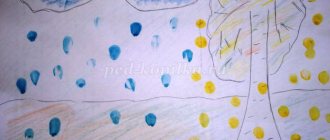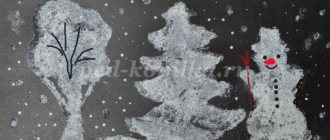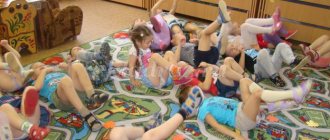Progress of the lesson:
I. Organizational moment
Hello guys! (An audio recording of the sound of rain is heard.)
Children, listen, what do you think this sound is like? (To the sound of rain). What is this rain? (Water drops).
Setting the goal of the lesson:
Guys, let's draw raindrops with water. Please come to my table. (Children approach the demonstration table).
II. Creative and exploratory work of children
Guys, please guess the riddle:
Riddle about the cloud
Sacks with holes in them run like a crowd across the sky, and sometimes water flows from the bags. Let's hide better From the leaky one. (clouds)
That's right, it's a cloud. Look how I draw a cloud with wax crayons.
(The teacher demonstrates the technique of drawing clouds with wax crayons. While drawing, the teacher talks with the children about clouds and clouds).
What color are clouds? (Black, blue, and the clouds are white). What falls from the cloud to the ground? (Rain, hail, snow). Where can it rain? (On the street).
It's going to rain from my cloud now. I'll paint it with water. Look what's in the glass? (Water). What color is the water? (Transparent). Do you think it is possible to paint raindrops with clear water? (No). Why? (The droplet will not be visible). So, what do we need to do with the water to make it visible? (Paint the water with paint). Well done, you guessed it.
(The teacher invites one of the children to paint over the water in a glass with a brush with gouache).
What color is the water in the glass? (Children name the color of the water in the glass. The color can be different, at the child’s discretion, since the palette contains gouache of different colors).
Look what I have in my hands? (Shows a pipette). That's right, a pipette. We will draw raindrops with an eyedropper.
Clarification of safety rules:
Look, the pipette is made of glass. Can you put glass in your mouth? (No). Throw the pipette on the floor? (No). Why? (It may break and you can cut yourself with glass shards).
Watch how I draw rain with an eyedropper.
(The teacher demonstrates how to draw rain with water from a pipette. During the show, she tells and shows how to draw water into a pipette and distribute droplets of water over the entire surface of the album sheet).
Now, guys, let's prepare our fingers for drawing.
Finger gymnastics “Rain”
Rain, rain, drop, Water saber, I cut the puddle, I cut the puddle, I cut, I cut, I didn’t cut, And I got tired and stopped. (I. Tokmakova)
(Children rhythmically tap the palm of their other hand with their index finger, gradually slowing down the pace, according to the text of the poem).
Guys, close your eyes, listen to the sound of the rain and think what color your rain will be. (An audio recording of the sound of rain is heard.)
Have you thought about it? Now sit down at your desks and get to work.
(Children work independently. Individual help from a teacher as needed. While children work, an audio recording of the sound of rain is played).
Smart girls. Now the rain has stopped. In the meantime, while the raindrops are drying from your clouds, come out to me and let’s play a game.
Dynamic game "Rain"
Rain, rain, rain and rain. (Children show raindrops on their palms with their fingers)
Don't be sorry for the wet drops. We clap our hands (Perform movements according to the text of the poem)
We stomp our feet. The sun is out again and the children are all going for a walk. (Perform movements according to the text of the poem)
(An audio recording of the sounds of rain is played, children run away under the teacher’s umbrella).
III. Lesson summary
The game is over and your raindrops have dried up. Please take your works and bring them to my table.
What a fabulous, unusual rain you made! (The teacher and the children look at the drawings and discuss the color of the rain). Guys, what did you draw? What did you use to draw raindrops? Did you like the lesson?
As a keepsake of our lesson, I give you balloons. They are blue and look like raindrops.
In 1930, the film “The Rogue Song” about the kidnapping of a girl in the Caucasus Mountains was released in America. Actors Stan Laurel, Lawrence Tibbett and Oliver Hardy played local crooks in this film. Surprisingly, these actors are very similar to the heroes.
Notes on drawing in the middle group Topic: “Rain, rain, drop”
Compiled by Elena Viktorovna Kiseleva, teacher of the first qualified category
Drawing notes
Subject:
"Rain, rain, drop"
Target
: developing children’s skills to create an image of rain using an unconventional drawing method (using pipettes).
Tasks:
Educational:
introduce the technique of drawing rain with a pipette, evenly distributing drops of water over the surface of a landscape sheet. Continue to teach how to convey simple phenomena of reality in drawing. Learn to combine actions with the words of a poem.
Developmental:
promote the development of imagination, fine motor skills, and an aesthetic attitude towards the surrounding world.
Educational:
to cultivate a sensitive and caring attitude towards nature and the beauty of the surrounding world, to evoke an emotional response.
Materials: white album sheet, wax crayons, plastic glasses with water.
Palette with paints, brushes, wet wipes. Brush holders, easel, umbrella. Motivation
B :
Hello guys! (An audio recording of the sound of rain is heard.)
Children, listen, what do you think this sound is like? (To the sound of rain). What is this rain? (Water drops).
Guys, let's try to draw raindrops with water. Please come to my table.
Communication, listening to music.
Updating of reference knowledge
IN:
Guys, please guess the riddle:
Sacks with holes in them run like a crowd across the sky, and sometimes water flows from the bags. Let's hide better From the holey cloud
That's right, it's a cloud. Look how I draw a cloud with wax crayons.
(The teacher demonstrates the technique of drawing clouds with wax crayons. While drawing, the teacher talks with the children about clouds and clouds).
What color are clouds? (Black, blue, and the clouds are white). What falls from the cloud to the ground? (Rain, hail, snow). Where can it rain? (On the street).
Educator:
It's going to rain from my cloud now. I'll paint it with water. Look what's in the glass? (Water). What color is the water? (Transparent). Do you think it is possible to paint raindrops with clear water? (No). Why? (The droplet will not be visible). So, what do we need to do with the water to make it visible? (Paint the water with paint). Well done, you guessed it.
(B: invites one of the children to paint over the water in a glass with a brush and gouache).
IN:
What color is the water in the glass? (Children name the color of the water in the glass). The color may be different, at the discretion of the child, since the palette contains gouache of different colors).
Educator:
Look what I have in my hands? (Shows a pipette).
That's right, a pipette. We will draw raindrops with an eyedropper.
Clarification of safety rules:
Look, the pipette is made of glass. Can you put glass in your mouth? (No). Throw the pipette on the floor? (No). Why? (It may break and you can cut yourself with glass shards).
Educator:
Watch how I draw rain with an eyedropper.
(The teacher demonstrates how to draw rain with water from a pipette. The teacher tells and shows how to draw water into a pipette and distribute droplets of water over the entire surface of the album sheet).
Educator:
Now, guys, let's prepare our fingers for drawing.
Finger gymnastics “Rain”
Rain, rain, drop, Water saber, I cut the puddle, I cut the puddle, I cut, I cut, I didn’t cut, And I got tired and stopped.
(Children rhythmically tap the palm of their other hand with their index finger, gradually slowing down the pace, according to the text of the poem).
Formation of new knowledge
IN:
Guys, close your eyes, listen to the sound of the rain and think what color your rain will be. (An audio recording of the sound of rain is heard.)
Have you thought about it? Now sit down at your desks and get to work.
Smart girls. Now the rain has stopped. In the meantime, while the raindrops are drying from your clouds, come out to me and let’s play a game.
Dynamic game "Rain"
Rain, rain, rain and rain. (Children show raindrops on their palms with their fingers)
Don't be sorry for the wet drops. We clap our hands and stomp our feet. The sun is out again and the children are all going for a walk. (Perform movements according to the text of the poem)
(An audio recording of the sounds of rain is played, children run away under the teacher’s umbrella).
Listening to music
Motor, play
Reflection.
The game is over and your raindrops have dried up. Please take your works and bring them to my table. What a fabulous, unusual rain you made! Guys, what did you draw? What did you use to draw raindrops? Did you like the lesson?
Guys, in front of you there are red and blue circles, those who think that they have completely coped with the task take the red circle, those who needed help from the teacher take the blue circle.
As a keepsake of our lesson, I give you balloons. They are blue and look like raindrops.
Summary of educational activities in drawing for the middle group “Rain, rain, drop.
Summary of a lesson on speech development in the 1st junior group
"The rain sings a song"
Lesson on speech development “The rain sings a song” Purpose: To develop cognitive interest and curiosity. Develop children's speech. Progress: Guys, a drop of rain came to visit us, and her name is Kapitoshka. Kapitoshka wants to tell you a riddle. Shall we listen? Children! Yes. - If the sun does not merge, what will pour from the sky onto the earth? Children! Rain. - Look, the captain came to the blue clouds and offers you to make rain come from these clouds. Want to try? Yes. - Go to the tables, take the cloud sponges in your hands. Squeeze in the river. It's raining? No. Why? - There is no water here. Place the sponge in your hand on a tray of water. Now take the sponge in your hand and squeeze it. Rain is coming? Yes. The rain came down heavily and torrentially. Grab some towels and dry your hands. We sit on the chairs. Listen to the poem “The Rain Sings a Song” - Light rain knocks on the roof, sometimes louder, sometimes quieter. Drip-drip, drip-drip. But it’s not just raining, the rain is singing a song! Drip-drip. — Look, drops of rain fell into a cup of paint. What color did the water become? (blue) - Do you want to draw rain with this water? Yes. We will paint not with a brush, but with a pipette. You already have clouds, you need to draw raindrops. Well done, that's how heavy the rain turned out to be. I’ll smile at myself, I’ll smile at you, I’m not too lazy to smile, I smile all day long. Hello, guys, I'm a drop of water, you really need me, I'll drip, I'll drip - I'll get water And you know how I drip (drip-drip...)
Research work! “Where is the water hidden?”
— The water is clear, milky white.
- I will hide the droplets in water and milk. Can you tell me where I hid the droplets and where it didn’t work out? It was not possible to hide it in the water because it is transparent. Physics!
“Rain clouds have arrived” Rain clouds have arrived (walking) Lei, rain, lei.
(clap our hands) The rains are dancing like living things (walking) Drink, rye, drink (jumping) And the rye is bending towards the earthly soil (walking) Drink, drinking, drinking (clap our hands) And the warm rain, restless rain (walking) It pours, it pours, it pours (jumping) The final part.
- Guys, what did we talk about today?
About water. -What kind of water is it? -How should you treat water? Summary of the lesson.
-What new did you learn today? -What was the most interesting?
I don’t know how many people love rain, but I know for sure that a lot of creative people use this phenomenon of capricious nature to convey the emotions that control a person in different life situations.
The theme of rain is one of the most popular in songwriting.
Songs that later become hits. The first association that comes to mind is Igor Talkov’s song “”. There is probably no person who has not heard this wonderful song and has not felt in his soul all the emotional coloring of the experience thanks to the theme of rain.
And indeed, rain can be warm and cold, its streams can hit or gently touch the human body. A thunderstorm is anger, a downpour is tears, and the sound of breaking drops always gives birth to a new melody.
I remember, as a child, more than once I took an umbrella, a small chair, and in the absence of my parents, I went out into the yard to sit and listen to the rain, which generously threw its drops on the old umbrella, and carried me away with its music into a fantasy world.
This is probably why I love rain so much and describe it in many poems.
Since school days, a poem by F.I. has been etched into my memory. Tyutchev “I love thunderstorms in early May.” When you read these familiar lines, you become completely immersed in this element of spring thunderstorm, lightning, rain and wind.
The theme of rain seems to be an endless topic, and I don’t know a classic poet who doesn’t have a poem describing such a seemingly familiar and at the same time slightly magical natural phenomenon.
Rain inspires; the nature of the rain can highlight the inner world of a literary hero or heroine and complement any image with bright colors.
Visiting exhibitions of famous and not so famous artists, I am always drawn to paintings where the theme of rain is present. I envy a little those people who, with the help of paints, can convey not only an image, but also a mood.
When you look at a picture, a whole story is born in your head. Be it an image of wet city streets, the riot of nature during a thunderstorm, or a sky landscape displayed in a puddle. Such paintings have always attracted, and will continue to attract, people, regardless of the artist’s skill. The old familiar rain will attract you on a subconscious level, as if it were something close, something that does not cause fear, but which you are surprised against against your will.
I also adore fine art photography as an art form. And I want to note that the theme of rain is very often used by professional photographers.
I am especially impressed by the color-saturated photographs of plants. It doesn’t matter whether it’s a droplet frozen on the edge of a burdock tree, or a wet, tender and lonely chamomile. Involuntarily your hand reaches out to such a photograph, you want to touch this wet splendor, breathe in the ozone-rich air, and mentally fly away to the place where the photographer captured this beautiful moment after the rain had left.
If you have never listened to the rain, caught its warm streams in the palm of your hand, put your face towards it, cried with it, and did not feel the childish joy of diamond drops, do it.
Let go of the conventions into which we sometimes drive ourselves, feeling the burden of responsibility of adult life. It doesn’t matter whether you run barefoot through puddles or simply stretch out your palm towards the rain. Make friends with him, become true allies.
And then I will ask: “Do you like rain? Do you love rain as much as I love it?
Summary of direct educational drawing activities on the topic: “Rain” for children of the second junior group Maria Smetankina, teacher of the second junior group MBDOU d/s No. 5 “Wave” Anapa 2013 Goal: development of artistic and aesthetic feelings through play activities Objectives: Teach rhythmically , apply strokes when depicting rain, placing them throughout the sheet, find the similarity of strokes with raindrops; develop pencil drawing skills. Create conditions for the development of oral speech components in various activities. Develop memory, attention, imagination, emotions, logical thinking; Develop aesthetic perception; Creative skills. Cultivate a desire to work; Establishing cause-and-effect relationships. Preliminary work: Creation of a subject-development environment. Watching an animated film: “Funny Garden” “Rain” Reading fiction: Looking at the illustration “Autumn” Observing the rain. Outdoor game: “Sun and Rain.” Vocabulary work: objects: rain, cloud, thunder, wind. actions of objects: drips, rattles, rumbles, blows Signs of objects: cold, damp, autumn. Equipment: easel, pencils, paper with painted clouds. Pictures depicting clothes (jacket, umbrella, rubber boots, slippers, hat, trousers). ICT: audio recording of the sounds of pouring rain and thunder, cartoon “Merry Garden”. Handouts: blue pencils, paper, trays with semolina cereals GCD procedure 1. Organizational moment (an audio recording of the sounds of pouring rain and thunder sounds). Educator: Guys, tell me, what do you hear? Children: Rain is falling, thunder is roaring. Educator: Do you like rainy weather? Children: No. Educator: Why? 2. Main part: (Children's answers) Educator: Please watch an excerpt from the cartoon “The Cheerful Vegetable Garden,” an episode where the vegetable garden dries up and rain comes to the rescue. Tell me, why do we need rain? Children: Trees, grass, flowers, vegetables need rain. Educator: Yes, and we have so much fun walking through the puddles if we dress for the weather. The teacher invites the children to compose an algorithm; the children are presented with pictures depicting clothes (jacket, umbrella, rubber boots, slippers, hat, trousers) Educator: Look carefully and choose the clothes that we will wear for a walk. Children: Make a choice and lay out the algorithm on the board. 3. Physical exercise “Rain” Teacher: Oh, guys! A cloud rolled in and it began to rain! Children tap their fingers on the floor or table. A thunderstorm flashed. They knock with their palms. Thunder rumbled. Children bang their fists. The rain began to subside and stopped completely. Gradually the rhythm slows down. During the exercise, the teacher can set the rhythm using a metallophone. “Rain, pour harder.” Rain clouds have arrived. Rain, rain, rain! Arms extended, palms down. The raindrops are dancing, shaking their arms, stamping their feet. Like the living, Drink, rye, drink! And the rye, bending towards the green earth, drinks, drinks, drinks, and the warm rain does not stop pouring, pouring, pouring! 4. Practical part Drawing. "It's raining". Educator: Now look, in my drawing it hasn’t started raining yet, although the clouds have already covered the sun. And then the first drops of rain fell to the ground. Drip-drip, drip-drip. (The teacher rhythmically makes strokes with a pencil, now speeding up, now slowing down.) The rain is getting quieter and has completely stopped, only puddles remain on the ground. The teacher invites the children to practice drawing techniques on cereals. Each child is given a tray of semolina. The task is to rhythmically apply small strokes on the tray with your index finger. Educator: What kind of rain will there be in your drawings? Work continues on a piece of paper with a pencil. Children draw raindrops, accompanying the drawing with the words: “Drip, drip, drip. " During the process, the teacher controls how they hold the pencil, helping children who have difficulty completing the task. 5. Final part At the end of the work, the drawings are displayed on the stand, the teacher and children find drawings depicting a strong “Oh, what a heavy rain in the drawings of ...!” and light rain “And here the rain is very light. Soon the sun will peek out from behind the clouds” (outdoor game “Sun and Rain”)





